Answers: May 12, 2022
Here are this week’s answers:
Question 1
HOW MUCH IMIDICLOPRID TO APPLY TO CRAPE MYRTLES
Dear Neil: I’ve read your information about applying Imidacloprid systemic insecticide as a soil drench to prevent crape myrtle bark scale. How do I determine the amount to use? Cheryl, Gordon (Palo Pinto Co.)
Answer: Thanks for the extra time to do the research, Cheryl. As I promised to do when you called my radio program Sunday, I spent much of an hour researching rates, products and timing for control of Crape Myrtle Bark Scale. This publication from Mississippi State University is outstanding. Glad I found it. CMBS was first observed in Richardson TX in 2004. It took 11 years for it to get to Mississippi, but it is now there and they are quite upset about it. Pages 6-8 of this Extension report have the information you wanted. I think you’ll find it will answer all of your questions.
Return to list of this week’s questions.
Question 2
HOW TO GET RID OF HORSETAIL
Dear Neil: Horsetail started in the compost pile. I thought I had killed it there, but this year it has come back with a vengeance and it is spreading out into the lawn and landscape. I’m mowing it, but how can I kill it? C.S., Carrollton.
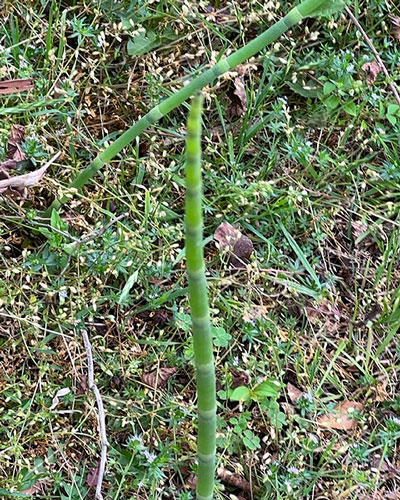
Answer: Horsetail (Equisetum) is a very ornamental landscape plant, but it can also be extremely invasive and hard to control – as you have discovered. This publication from Iowa State tells you how to control it in farm fields. I looked for 20 minutes, and it was the best explanation I could find. I’m sorry that their recommended product will control horsetail in an area 20 feet wide by one mile long! I would suggest talking to a farm supply store. They would have the products you would need, hopefully in smaller quantities. Otherwise you may have to resort to hand-digging and intensive methods to stop it before it spreads any farther.
Return to list of this week’s questions.
Question 3
WHAT IS WRONG WITH MY OAK LEAVES?
Dear Neil: What is going on with my Shumard red oak’s leaves? What can I do to correct it? E.W., Bowie.
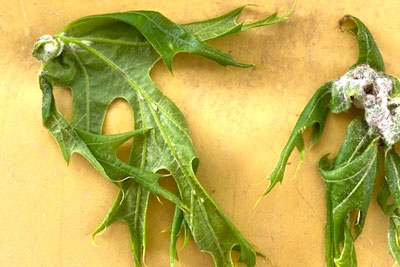
Answer: These are vein pocket galls. They’re caused by insects that have stung the tender new leaf tissues and laid their eggs inside. The plant’s response is to produce abnormal tissues around the larvae, which are then protected. They are temporarily disfiguring until the affected leaves fall off in a few weeks. They do little or no damage to the tree and there isn’t anything you can do to prevent or control them. In other words sit tight – things are going to be fine. For the record, there are dozens of other types of equally harmless galls that attack oaks and other tree species. You can ignore them as well.
Return to list of this week’s questions.
Question 4
WHY IS MONDOGRASS NOT GROWING?
Dear Neil: What is going wrong with my mondograss that it’s not growing? Tips are turning brown and some plants have died altogether. L.H., Watauga.
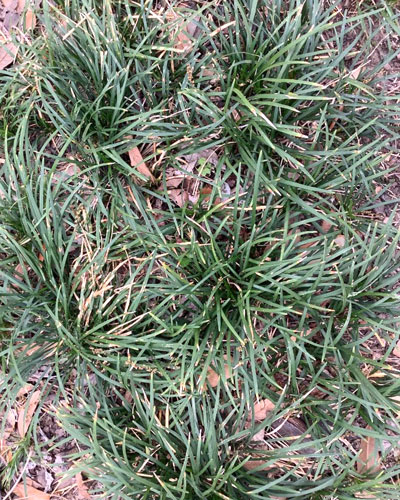
Answer: As one who has been growing mondograss as a prime groundcover for more than 40 years, now with ½-acre of it, I’ve had a lot of experiences with it. When I see the tips of my plants turning brown I think back to how I have watered it. It is intolerant of soggy soils, but it does benefit from highly organic planting soils that are kept moist at all times. My guess would be that it would be related to that. Distant possibilities would be fertilizer applied without following it up with a deep soaking. I guess it’s also possible that the soil stayed too wet for a prolonged period and crown rot moved in. You should have been able to tell that by digging a sample of soil near a dying plant to see if it was soggy. I guess it’s even remotely possible that a small outbreak of white grub worms (larval form of the common June bug) could have damaged isolated clumps. But my guess is that the problem is in the first group.
Return to list of this week’s questions.
Question 5
WHY NO FALL COLOR ON MY CHINESE PISTACHIO?
Dear Neil: After reading how great the red fall color of Chinese pistachios is I bought one four years ago. So far, no color at all. Not one hint of red. I wrapped its trunk to protect against sun scald as you suggested. I think I followed all the guidelines. I’m very disappointed. P., Cleburne.
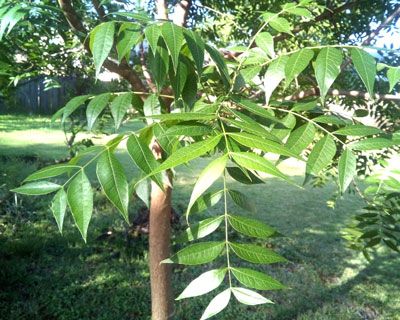
Answer: Any competent horticulturist who writes or talks about fall color in Texas will caution that it will vary from species to species – and from year to year. Generally, the farther east you go in Texas, the more likely you are to have good fall color. And, Chinese pistachios are certainly among our best performers of all of our shade trees. But hot, dry weather in September the past two autumns really hurt the fall color in big swaths of Texas. I took only a few photos of fall color in 2021, none of them of Chinese pistachio. Be patient. It will kick in and you will be rewarded. In the meanwhile you will have one of the best shade trees for Texas the other 50 weeks of the year.
Return to list of this week’s questions.
Question 6
CAN ANYTHING BE DONE TO HELP THIS CUT LIMB HEAL?
Dear Neil: Is there anything I should do to help this cut branch heal any better? T. Cisco.
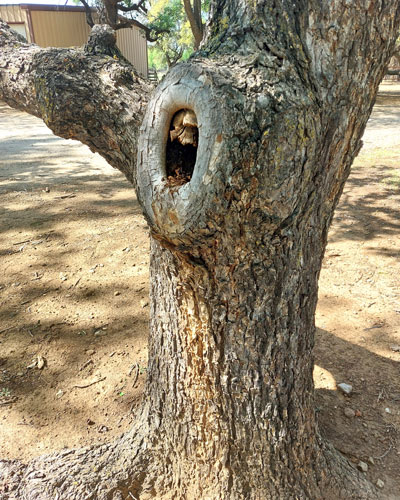
Answer: You pose a very interesting question and I have several thoughts. The donut of new bark is forming absolutely perfectly across the opening. You couldn’t wish for a better job of healing. Unfortunately, I do see a hint of the decay that is going on within the center of the trunk. I also see a streak of lighter bark above and especially below this area on the bark. That might suggest something is amiss internally. It’s unfortunate that another branch arose at exactly the same spot on the trunk. There’s a possibility that the decay has moved out into it as well. I can’t tell if those are stubs of branches extending up from the top of that branch on the left, but if they are, they could be leading to additional decay internally on that branch. But at least this appears to be in an open area so if it ever should break maybe it won’t come down on a roof or car. If there is a certified arborist that you could hire to look at the tree that might be a good idea, but I’m not sure there would be one in Cisco. If not, just keep a close eye on things. Watch the vigor of the top growth. As long as it is strong the tree will probably be fine. But if it starts to weaken, especially if it happens on that side, you need to be concerned.
Return to list of this week’s questions.
Question 7
WHY WOULD ANTHONY WATERER SPIRAEAS DIE THIS YEAR?
Dear Neil: We have four Anthony Waterer spiraeas that are six years old. Each winter I cut them back by half and they have done fine. This year, however, some of them have died. Would it be a bad idea to plant more of them in the voids? N., Arlington.
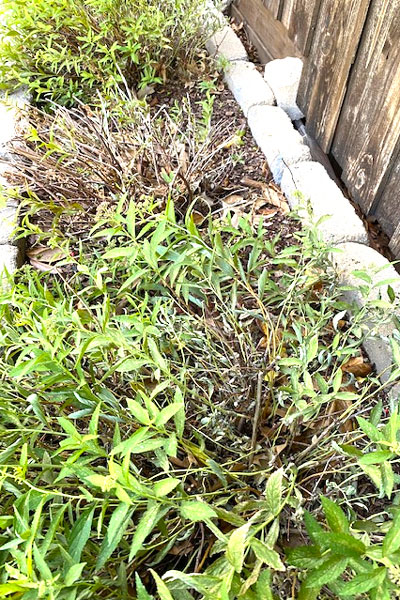
Answer: You always want to prune spring-flowering shrubs and vines immediately after they have finished blooming, Anthony Waterer spiraeas included. Winter pruning has been weakening your plants. I don’t know that that would have caused them to die out, but it certainly wouldn’t have helped. I spent some time online and found no reference to diseases that might have caused your problem, nor have I ever experienced any when I’ve grown Anthony Waterers in my own landscape. My only problem was that they became iron deficient after a few years. I had enough trouble counteracting the chlorosis that I eventually replaced mine.
Return to list of this week’s questions.
